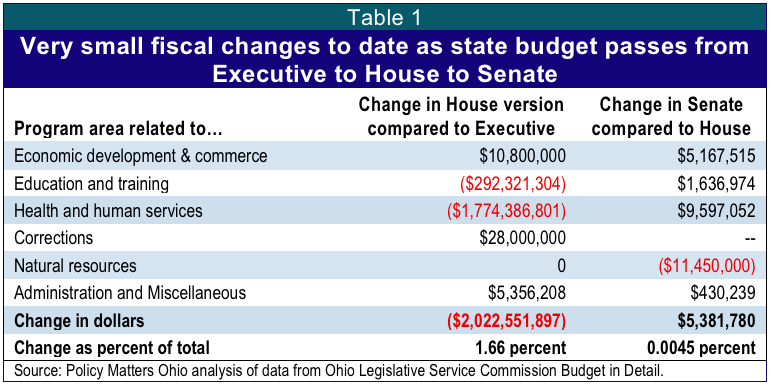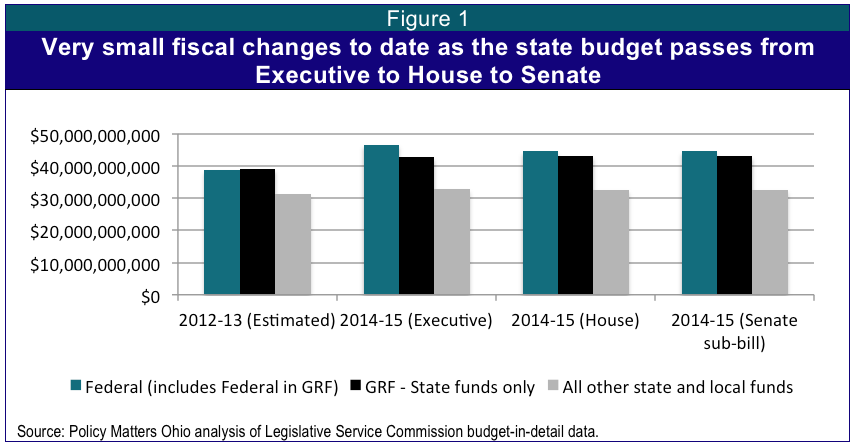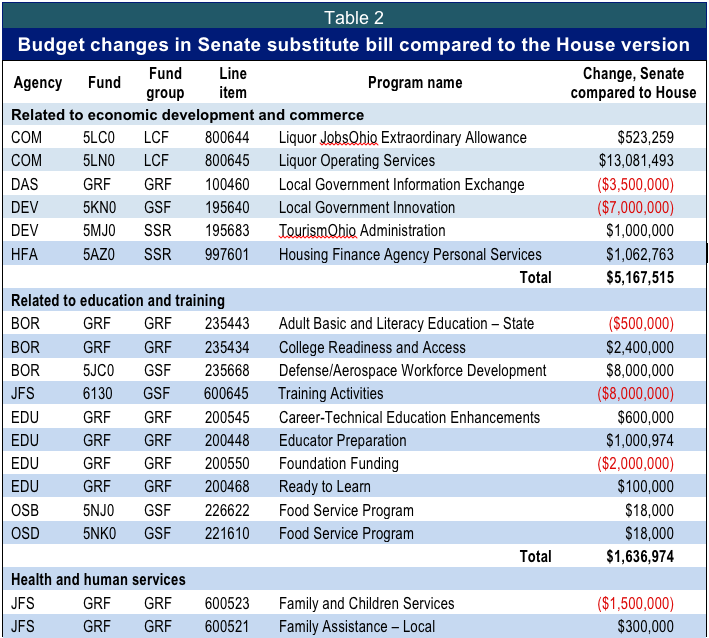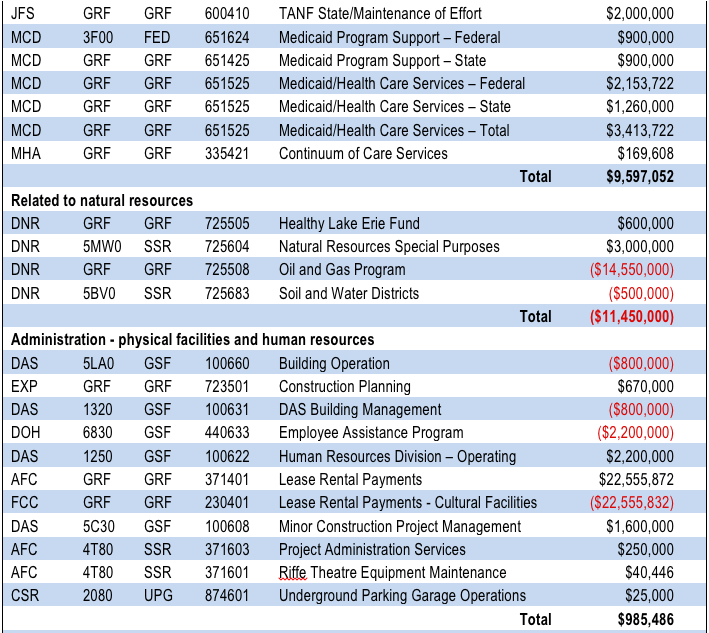
The budget moves in the Senate
June 03, 2013
The budget moves in the Senate
June 03, 2013
An update on House Bill 59 as the Senate introduces its substitute bill and the General Assembly prepares to bring Ohio's two-year budget into conference committee.
On May 28, the Senate released its substitute for House Bill 59, the state budget bill, It would increase expenditures by $5,381,780 or .0045 percent compared to the House version that has been under scrutiny for the past month; in other words, total funding has barely changed. The big-picture items, however – taxes, K-12 education, and Medicaid expansion – remain to be settled.
As of today, the fiscal changes we see as the budget bill has passed between the two chambers of the General Assembly may be grouped into six broad areas: economic development and commerce, health and human services, education and training, natural resources, corrections and administration, and miscellaneous. Table 1 shows the fiscal changes made by the House to the executive version, and by the Senate to the House version. (See Table 2 at end of report for greater detail.)
The most significant fiscal change occurred as the bill passed through the House, which removed Gov. Kasich’s proposal to expand Medicaid, and the federal dollars that would have gone with expansion. The reduction of $2.022 billion in this first iteration was about the same size as the $2.14 billion in federal Medicaid dollars removed from the budget.
As the budget is shaped in the Senate, the division of funds among state monies, federal monies, and all other sources (fees, trust funds, transfers, and other fund configurations) remains similar to the initial proposal. The General Revenue Fund (GRF), which is made up of state tax dollars, contained $42.7 billion in state-only funds in the executive budget (federal Medicaid and other federal funds accounted for in Ohio’s GRF have been removed here for the purposes of understanding state-only share). The House and Senate versions contain only slightly more – $43.1 billion.
The executive budget contained $46.6 billion federal dollars over the biennium; with the removal of Medicaid expansion monies, the House and the Senate versions contain $44.5 billion.
The remaining funds – from a variety of non-tax, non-federal sources – totaled $32.8 billion in the executive version of the budget. The House and Senate versions of the budget bill are very similar, with $32.6 billion.
Figure 1 illustrates how, strictly in fiscal terms, the 2014-15 budget has not changed much as it has passed through Ohio’s statehouse.
While expenditures are not changing much, tax proposals on the revenue side of the budget are very much in flux.
The Senate did not include an income tax cut in its version of the budget bill. The executive budget recommended a 20 percent cut in the personal income tax, taken over three years, while the House version recommended a 7 percent reduction. The Senate version removes the personal income tax cut altogether.
This is a positive development. Important services from adult protective services to local government aid are inadequately supported in Ohio, and income tax cuts, made for the stated purpose of creating desperately needed jobs, have failed to do so. Since the General Assembly approved income tax cuts in 2005, Ohio has trailed every state but three in job growth, and underperformed the nation before, during, and after the recession. Recently, the state has been reporting a lower unemployment rate than the nation, but that has more to do with Ohio workers leaving the labor force than it has to do with an increase in the number of jobs. Income-tax cuts have not worked to spur growth here.
The Senate has reinserted a business income tax exclusion recommended in the executive budget, but removed by the House. The provision is poorly targeted and is unlikely to result in significant new job creation. Among the key reasons this is bad for Ohio:
- Researchers at the U.S. Department of the Treasury recently found that, nationally, only 11 percent of taxpayers reporting business income own a bona fide small business with employees other than the owner;
- The taxpayers who would benefit from the exclusion would get so little on average that they couldn’t add employees in any meaningful way. Based on 2009 Ohio taxation department data, the median taxpayer benefiting from the exemption would be able to exclude annual business income of $3,103. Even if all of this income were taxed at the top rate, the exclusion would result in an annual tax cut of less than $200;
- The proposed business-income exclusion represents a windfall for affluent passive investors, and partners in law firms and other partnerships;
- The proposal increases the potential for tax avoidance, since it creates an incentive for owners of passthrough businesses to reclassify their income as “profit” – half of which would go untaxed – rather than “salary.”
The budget bill contains new tax loopholes, adding to the billions in special treatment already offered certain taxpayers. Many tax loopholes (expenditures) have continued for decades, draining state revenue and providing a special advantage to certain taxpayers, without an accounting for whether they serve their original purpose or even what that purpose is. Over the past decade, the General Assembly has repealed the corporate franchise tax and the estate tax, which included a combined total of 44 tax expenditures. Yet if the current version of this budget bill is approved, there will still be 131 state tax exemptions, credits or deductions, just seven fewer than a decade ago. The proposal as it stands includes:
- A broadening of the sales-tax exemption for purchases of data-center equipment;
- A new exemption for the aerospace industry. Gov. Kasich vetoed an identical tax break less than a year ago, saying: “Aerospace is a valued industry in Ohio but there is no justification for granting this specific industry such a broad exemption for its research and development efforts.”
The Senate did not reinstate the severance tax on oil and gas that the House removed from the executive budget. Ohio needs to modernize its tax system so it covers today’s industries. This means a severance tax that will capture more than the current tiny share of revenue the state collects as hydraulic fracturing depletes the state’s resources. Studies of the oil and gas industry over the past 40 years make clear that state tax rates have little if any impact on oil and gas production.
The Senate bill retains the executive and House provisions for collecting the use tax due on catalog and Internet purchases. This is not a new tax; the use tax has been in place since the 1930s. Separate from the collection of taxes already due, the shrinking share of Ohio’s economy that is covered by the sales tax mandates an evaluation to determine which services should be added to the sales-tax base.
Ohio’s state and local tax structure takes a larger share of income from poor and middle-income Ohioans than from the most affluent. Ohio residents in the middle fifth of the income spectrum pay 10.6 percent of their income in such taxes, compared to just 8.1 percent for those in the top 1 percent. Those in the bottom fifth pay relatively more: 11.6 percent (See report based on analysis by the Institute on Taxation and Economic Policy, www.policymattersohio.org/income-tax-jan2013). Ohio’s tax system should be overhauled to produce the revenue we need for public services and investments that support our economic success, and help maintain and improve our quality of life. At the same time, it needs to depend less on low- and middle-income Ohioans, and more on those who can afford it.
As the budget emerges from the Senate, many urgent needs remain unmet:
- More funds are needed for foodbanks to feed the hungry;
- Stakeholders have asked for $20 million to fund and staff Adult Protective Services, a state mandate for local government that has seen state funding and local staffing drop significantly over two decades even as the senior population has grown. Throughout the nation, elder abuse is increasingly known as the “silent epidemic” because of underreporting and lack of detection.
- The removal of Medicaid expansion from the budget means that restoration of important health and human services will be impossible. Addiction and mental health services, in particular, are areas where even the new state funds included in the General Assembly versions of the budget bill fail to make up for a decade of disinvestment.
Tags
2013Budget PolicyRevenue & BudgetTax PolicyPhoto Gallery
1 of 22




